Thread Starter
- Mitglied seit
- 11.03.2007
- Beiträge
- 27.708
- Ort
- München
- Details zu meinem Desktop
- Prozessor
- AMD Ryzen 7 9800X3D @ 5,4 GHz
- Mainboard
- ASUS ROG Strix X870-F Gaming WIFI
- Kühler
- NZXT Kraken X73 RGB
- Speicher
- 32GB Corsair Vengeance DDR5 @ 6200 MHz CL28
- Grafikprozessor
- ZOTAC GAMING GeForce RTX 5080 SOLID
- Display
- Alienware AW2723DF @ 280 Hz
- SSD
- Western Digital WD_BLACK SN850X NVMe SSD 2TB
- Soundkarte
- Beyerdynamic T5p @ Beyerdynamic USB-DAC
- Netzteil
- Seasonic Prime TX-1000W
Intel Ivy Bridge (Sockel 1155) Gerüchte + FAQ + Infos
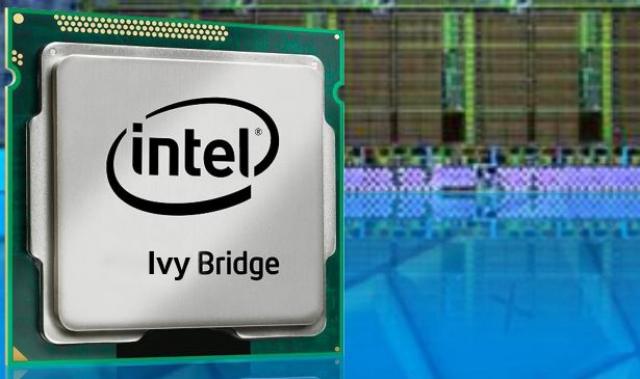

Facts:
Mit Ivy Bridge steht im nächsten Jahr eine neue Intel-Prozessorengeneration für das Mainstream-Segment an.
Diese CPUs basieren weitgehend auf der aktuellen Sandy Bridge-Architektur, werden aber im kleineren 22-nm-Prozess gefertigt.
Sie können weiterhin in Mainboards mit Sockel LGA 1155 eingesetzt werden.
Voraussichtlicher Release: 08. April 2012 (Neue Chipsätze), 23. April 2012 (Desktop) + 3. Juni 2012 (Dual Core Prozessoren + Mehr Chipsätze)
Fertigung: 22 nm (3D-Transistoren)
TDP: 77W (statt 95W)
Grafikeinheit: Intel HD 4000
Sockel: LGA 1155
Chipsätze: Z77, Z75, H77, Q77, Q75, B75 (sowie Z68, P67, H67 usw. nach BIOS Update)
Versionen: K = Freier Multiplikator, S = Stromspar, T = Noch mehr Stromspar/Niedrigere TDP (+Takt)
Testbericht:
http://www.hardwareluxx.de/index.php/artikel/hardware/prozessoren/22181.html
Verbesserungen:
Core:
- Verbesserter Befehlssatz (insbesondere SSE und AVX)
- Zufallszahlengenerator
- Neue Speicheradressierung namens SMEP (Programm, das mit eingeschränkten Rechten läuft, kann mit SMEP nicht mehr Rechte von OS oder Kernel erlangen)
iGPU (HD 4000):
- DirectX11 Support
- 3 Display Support
- 16 EUs
- Bessere Anisotrope Filterung
- Eigener L3-Cache
- Leistung 60% (3DMark Vantage) bzw. 30% (3DMark 06) schneller als HD 3000.
System-Agent:
- Kann im Deep-Sleep-Modus DDR I/O komplett abschalten
- TDP-Konfigurierung (Ultra Low Volt und Extreme Edition CPUs sollen drei TDP-Angaben besitzen (nominelle, verminderte, erhöht))
- System-Agent benötigt geringere Spannung als Sandybridge
- Power-Aware-Interrupt-Rating (PAIR) wählt bei der Verarbeitung von Interrupts automatisch den besten Core
- Versorgungsspannung wird besser an Taktfrequenz angepasst
- Offizielle Unterstützung von DDR3-2133.
Ivy Bridge Prozessoren für den Desktop:
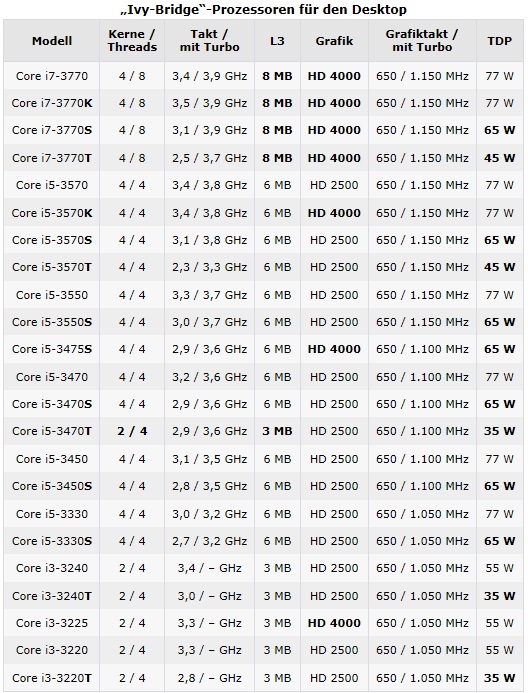
Quelle: Intel gibt 28 „Ivy-Bridge“-Modelle offiziell preis - ComputerBase
Ivy Bridge Prozessoren für den Mobilen Markt:
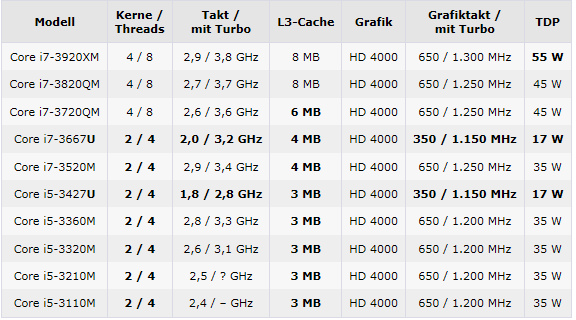
Quelle: Start der ersten 22-nm-CPUs am 8. April 2012? - 28.12.2011 - ComputerBase
Die neuen Panther-Point Chipsätze:
- PCI Express 3.0 mit 16 Lanes
- Native USB-3.0-Unterstützung mit vier Anschlüssen
- Unterstützung von bis zu 3 Displays
- HDMI 1.4a (3D Ready)
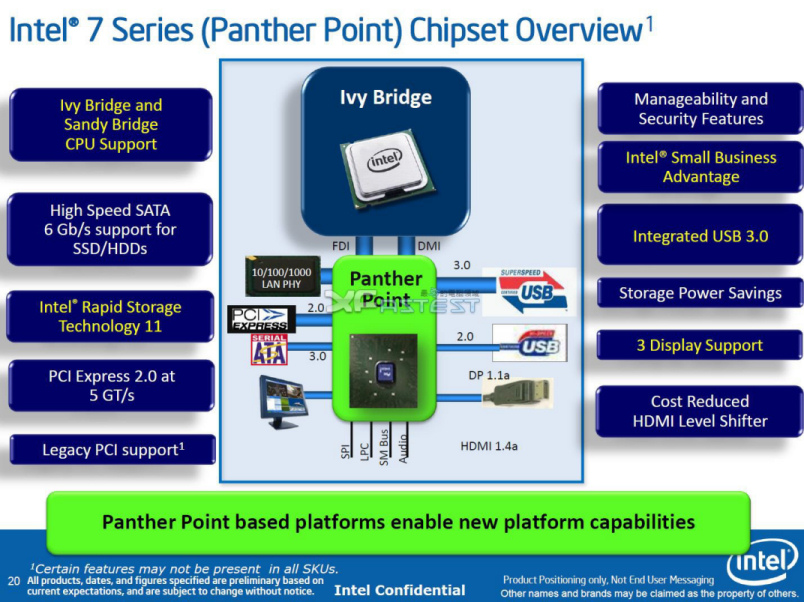
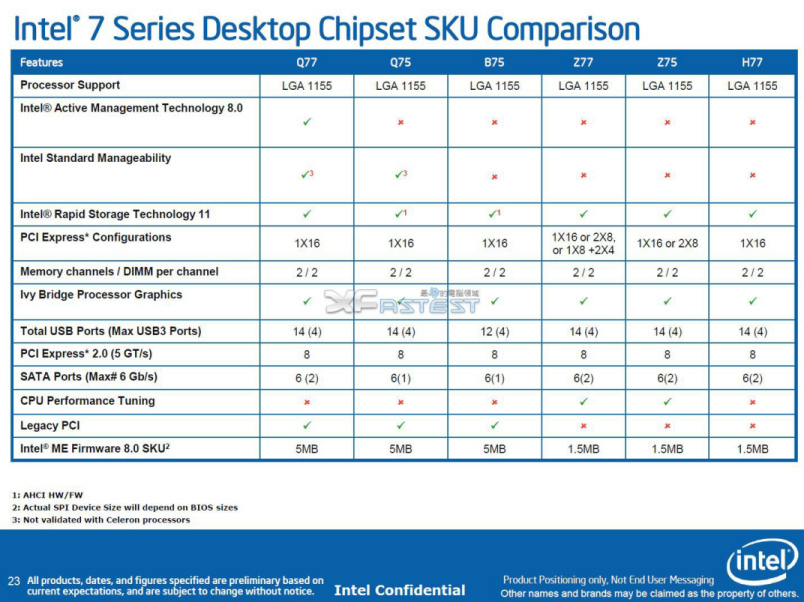
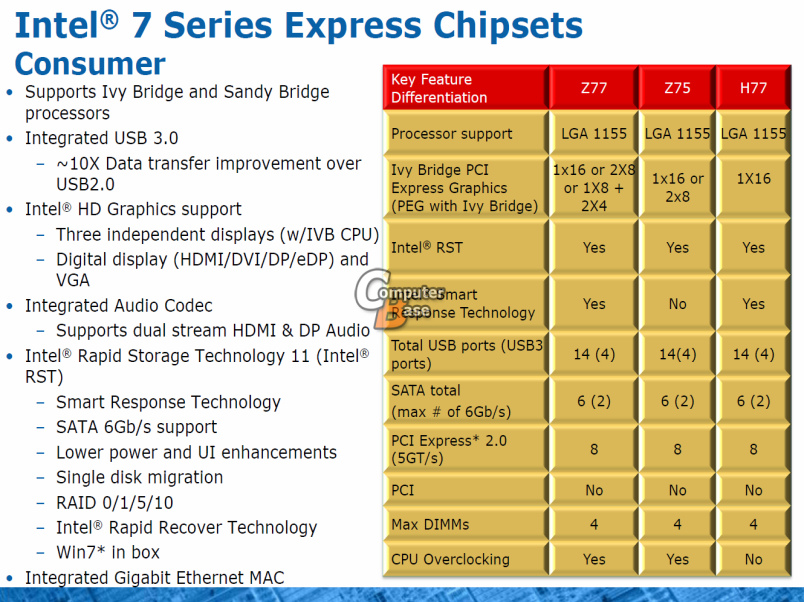
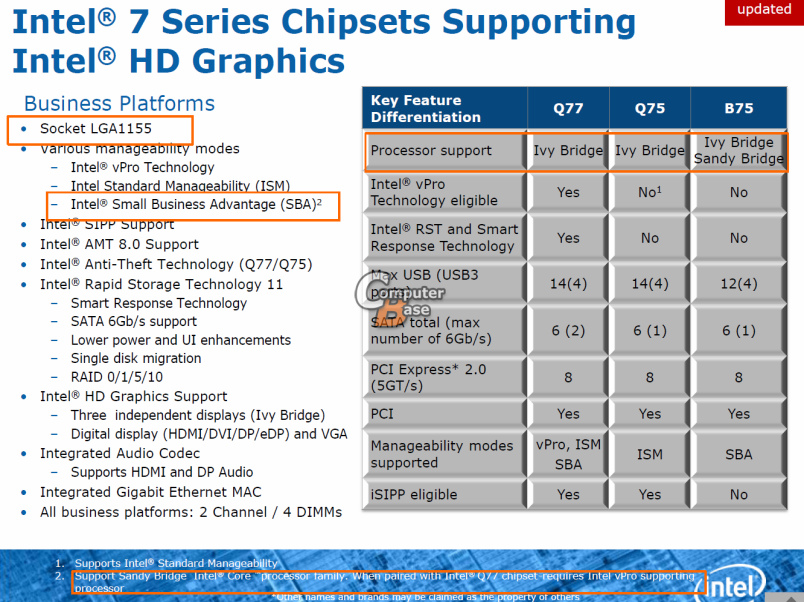
Die revolutionäre 3D-Transistor Technik:
Die große Neuerung betrifft das Gate, also die aktiv schaltende Komponente des Transistors. Im Gegensatz zu den bisherigen "planaren" Transistoren wächst das Gate in die Höhe (wird also in die dritte Dimension erweitert). Durch die größere Kontaktfläche wird der Ansteuerungsstrom erhöht, wodurch eine höhere Leistung ermöglicht wird.
Ein weiterer Vorteil des dreidimensionalen Aufbaus ist, dass negative, zu Leckströmen führende Einflüsse vermieden werden.
Durch eine Senkung der Schwellspannung können die Transistoren bei einer niedrigeren Spannung betreiben werden und so die Leistungsaufnahme reduziert werden oder die Schaltgeschwindigkeit erhöht werden.
Außerdem fliesst der Strom so besser, wenn der Transistor eingeschaltet ist (für mehr Rechenleistung) und es gibt weniger Verlust, wenn der Transistor ausgeschaltet ist (um Energie zu sparen). Daraus resultieren schnellere und gleichzeitig sparsamere Produkte.
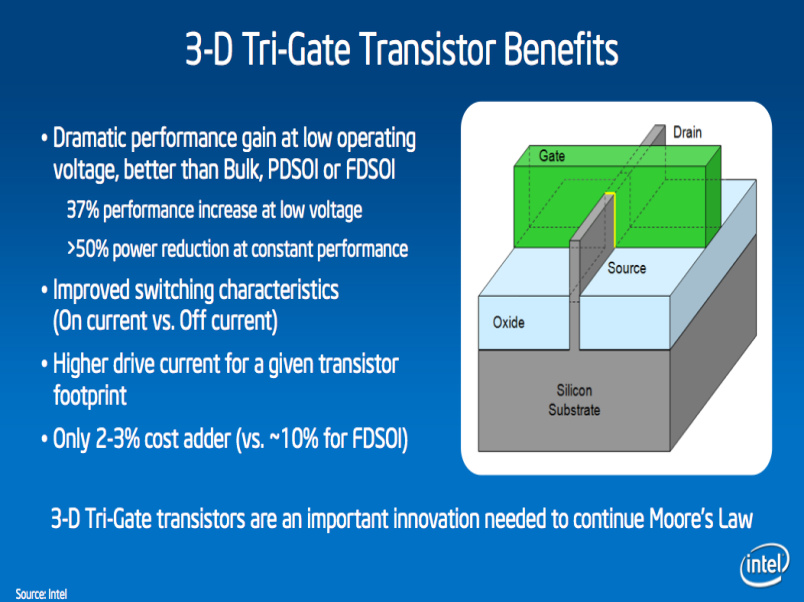
Benchmarks:
Prognose: Sandy Bridge vs Ivy Bridge bei gleichem Takt -> Hoher einstelligen oder knapp zweistelliger Prozent-Zuwachs für Ivy gegenüber Sandy (noch keine wirklich vergleichenbaren Benchmarks verfügbar). Die neue iGPU HD 4000 soll 60% (3DMark Vantage) bzw. 30% (3DMark 06) schneller laufen als die alte HD 3000.
Neue Ivy Bridge Panther-Point Boards:
ASRock
ASRock Z77 Extreme6
- 2x PCI-Express 3.0 x16 (bei SLI 8x), 1x PCI-Express 2.0 x16 (faktisch 4x über PCH), 1x PCI-E 1x, 2x PCI
- 4x SATA 6 Gb/s ports, 4x SATA 3 Gb/s
- DVI, HDMI, DisplayPort, und D-Sub Ausgänge
- 4x USB 3.0 Extern, 2x USB 2.0 Extern, 1x Gbit LAN, 1x eSATa, 1x Firewire, 2x USB 3.0 Intern, 6x USB 2.0 Intern und 1x Firewire Intern
- 12-Phasen-DigiPower-Spannungsversorgung, DDR3-2800 Support, Power/Reset Button und Debug-Anzeige
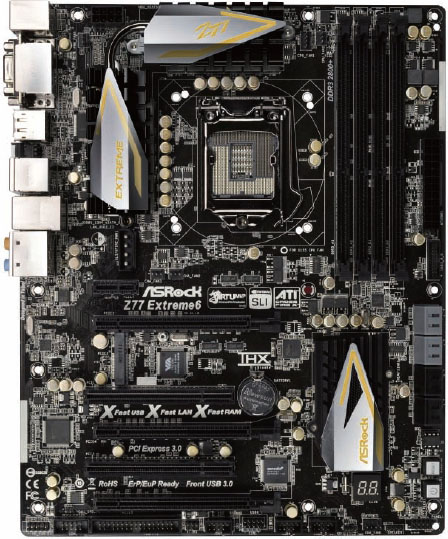
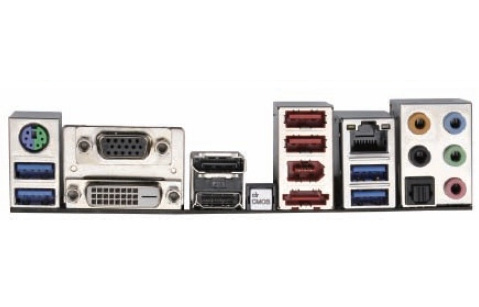
ASrock Z77 Professional (Fatal1ty):
- 3x PCI-Express 3.0 x16 (faktisch ?), 2x PCI-E 1x, 2x PCI
- 6x SATA 6 Gb/s ports, 4x SATA 3 Gb/s
- DVI, HDMI, DisplayPort, und D-Sub Ausgänge
- ?x USB 3.0 Extern, ?x USB 2.0 Extern, ?x Gbit LAN, ?x eSATa, ?x Firewire, 2x USB 3.0 Intern, 6x USB 2.0 Intern und 1x Firewire Intern
- 20-Phasen-DigiPower-Spannungsversorgung, DDR3-2800 Support, Power/Reset Button und Debug-Anzeige
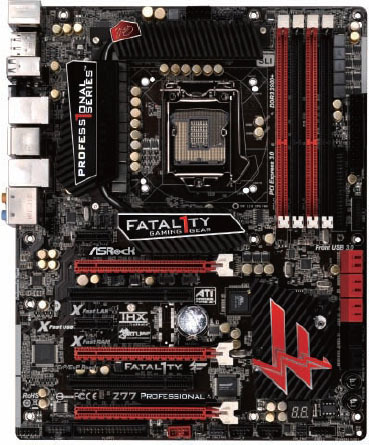
ASrock Z77 Professional-M (Fatal1ty):
- 1x PCI-Express 3.0 x16, 1x 1x PCI-Express 2.0 x16 (4x angebunden über PCH), 2x PCI-E 1x, 2x PCI
- 4x SATA 6 Gb/s ports, 4x SATA 3 Gb/s
- DVI, HDMI, DisplayPort, und D-Sub Ausgänge
- ?x USB 3.0 Extern, ?x USB 2.0 Extern, ?x Gbit LAN, ?x eSATa, ?x Firewire, 2x USB 3.0 Intern, 6x USB 2.0 Intern und 1x Firewire Intern
- 11-Phasen-DigiPower-Spannungsversorgung, DDR3-2800 Support, Power/Reset Button
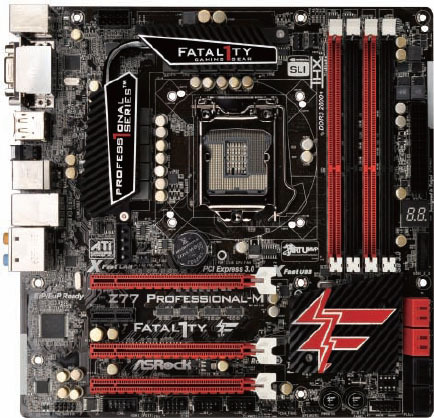
Asus
ASUS P8Z77-V Deluxe
- 2x PCI-Express 3.0 x16 (bei SLI x8/x8), PCI-Express 2.0 x16 (elektrisch x4, über PCH angebunden), 4x PCI-E 1x
- 4x SATA 6 Gb/s ports, 4x SATA 3 Gb/s
- HDMI und DisplayPort
- ?x USB 3.0 Extern, ?x USB 2.0 Extern, 2x Gbit LAN, 2x eSATa, ?x USB 3.0 Intern, ?x USB 2.0 Intern
- DDR3-2800 Support, Wireless b/g/n (Quad-band), Bluetooth 3.0, 8+2 Kanal-HD-Audio (Realtek ALC898)
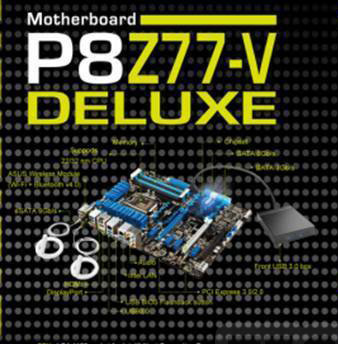
Gigabyte
Gigabyte G1.Sniper 3
- 2x PCI-Express 3.0 x16 (bei SLI x16 dank PLX-Bridge, bei 4-way SLI x8), 2x PCI-Express 2.0 x16, 2x PCI-E 1x, 1x PCI
- 6x SATA 6 Gb/s ports, 4x SATA 3 Gb/s
- DVI, HDMI, Displayport und D-Sub Ausgänge
- 6x USB 3.0 Extern, 2x LAN Extern, 4x USB 3.0 Intern, 4x USB 2.0 Intern und 1x Firewire Intern
- Onboard Gigabit Killer Nic Network Card, Onboard Creatives Sound Core3D-Audiochip (inkl SPDIF), Intel Gigabit Network, 2x BIOS/UEFI DualBIOS, 6x SmartFan Fananschlüsse
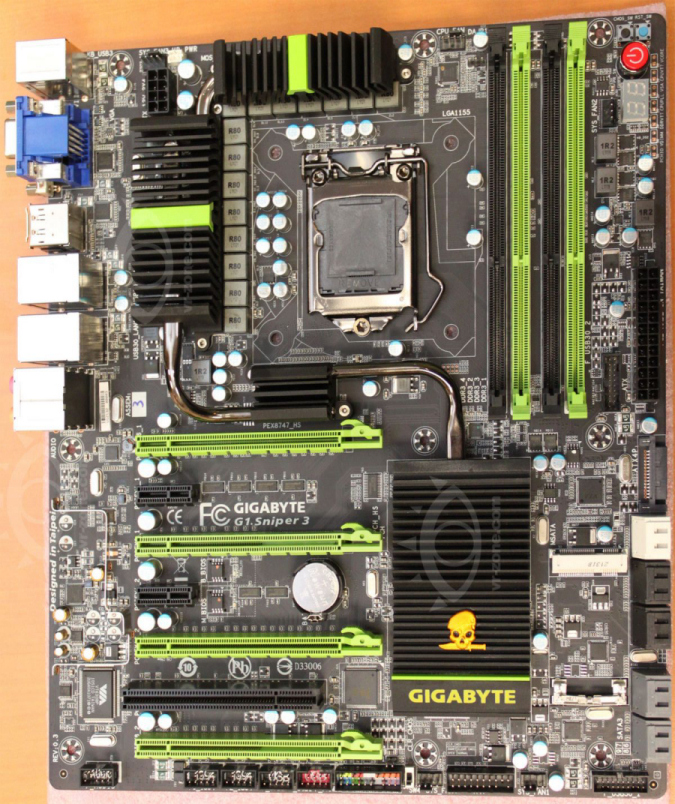
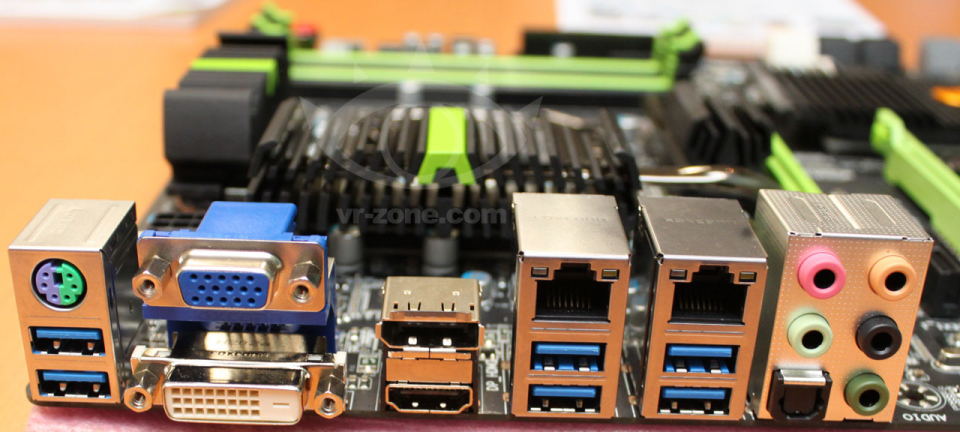
Gigabyte G1.Sniper M3
- 2x PCI-Express 3.0 x16, 1x PCI-Express 2.0 x16 (elektrisch x8/x8/x4 wenn SLI/belegt), 1x PCI-E 1x
- 2x SATA 6 Gb/s ports, 3x SATA 3 Gb/s
- DVI, HDMI, Displayport und D-Sub Ausgänge
- 2x USB 3.0 Extern, 2x USB 2.0 Extern, 2x USB 3.0 Intern und 4x USB 2.0 Intern
- Intel Gigabit Ethernet Network Card, Onboard Creatives Sound Core3D-Audiochip (inkl SPDIF), 2x BIOS/UEFI DualBIOS, 4x SmartFan Fananschlüsse
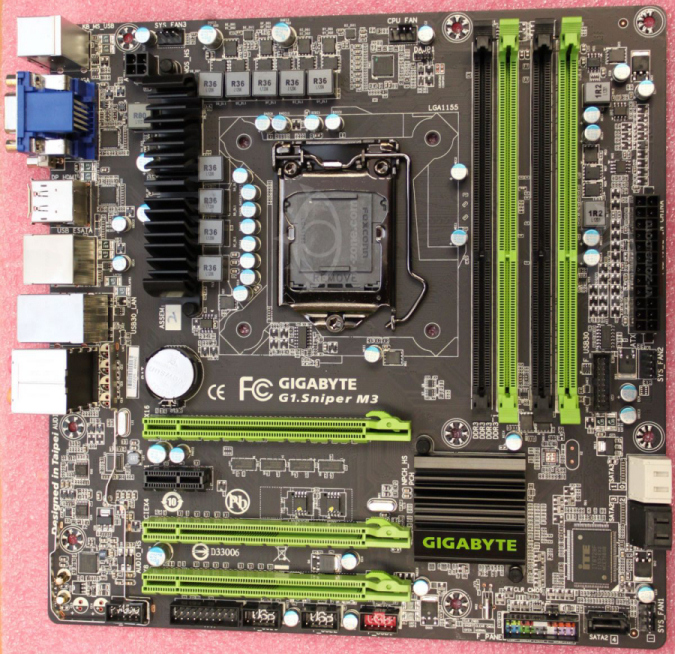
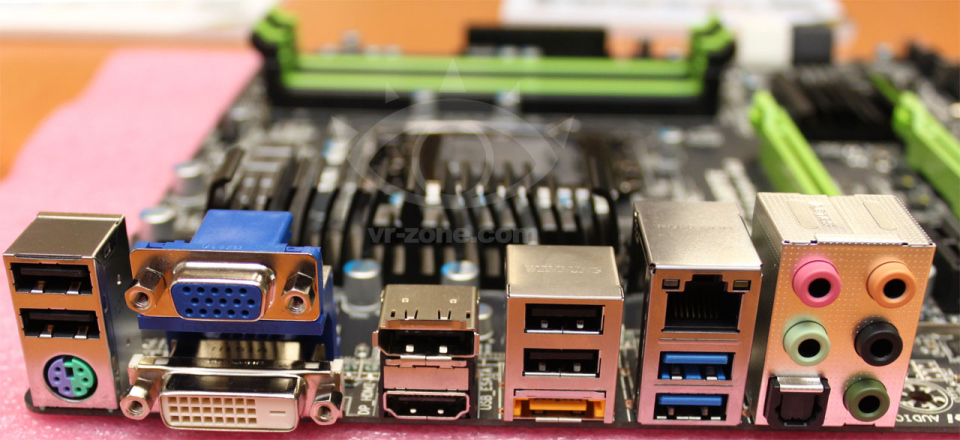
Gigabyte GA-Z77X-UD3H
- 2x PCI-Express 3.0 x16 (elektrisch x8/x8/ bei SLI/Belegung), 1x PCI-Express 2.0 x16 (elektisch x4 über PCH angebunden), 3x PCI-E, 1x PCI
- 3x SATA 6 Gb/s ports, 4x SATA 3 Gb/s
- DVI, HDMI, Displayport und D-Sub Ausgänge
- 6x USB 3.0 Extern, 2x eSATA Extern, 2x USB 3.0 Intern, 6x USB 2.0 Intern, mSATA Intern
- Gigabit Ethernet, VIA HD Audio mit SPDIF Ausgang, 2x BIOS/UEFI DualBIOS, 4x SmartFan Fananschlüsse, Spannungsmesspunkte und Debug LEDs
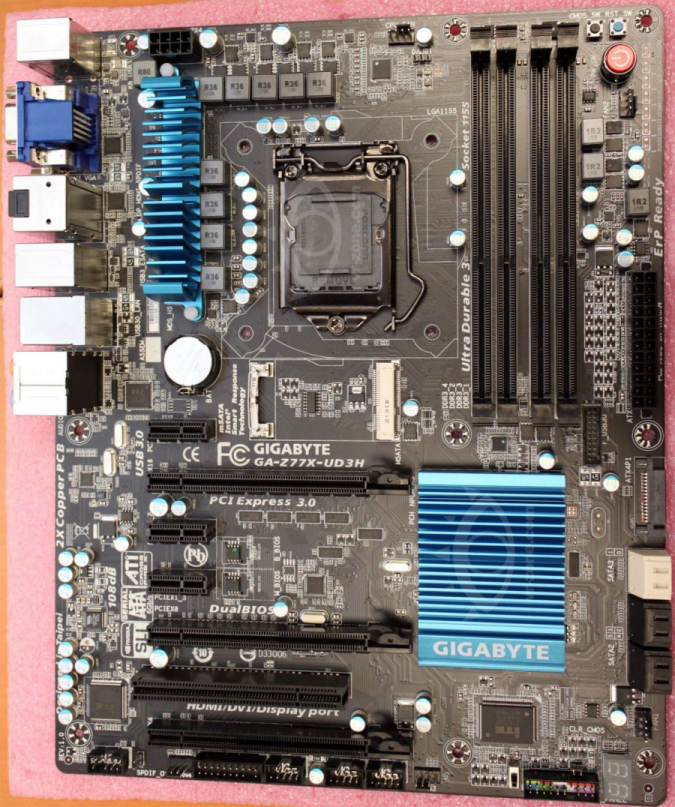
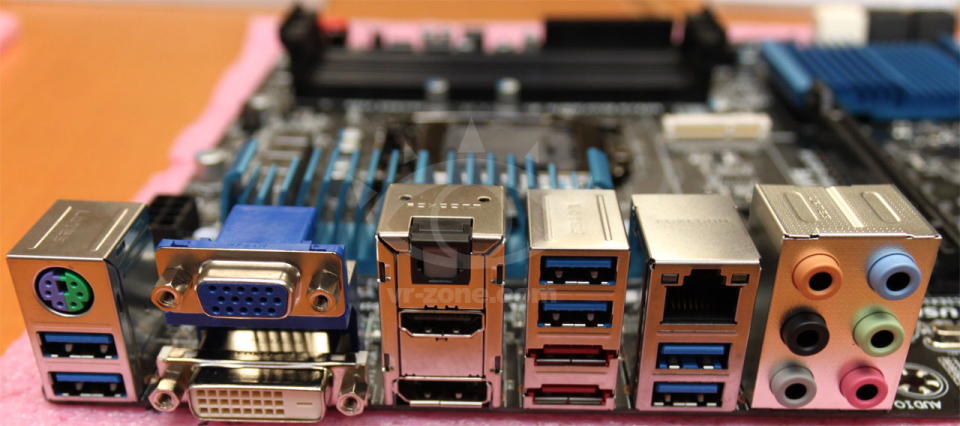
Gigabyte GA-Z77X-UD5H
- 2x PCI-Express 3.0 x16 (elektrisch x8/x8/ bei SLI/Belegung), 1x PCI-Express 2.0 x16 (elektisch x4 über PCH angebunden), 3x PCI-E x1, 1x PCI
- 5x SATA 6 Gb/s ports, 4x SATA 3 Gb/s
- DVI, HDMI, Displayport und D-Sub Ausgänge
- 4x USB 3.0 Extern, 2x USB 2.0 Extern, 1x Firewire Extern, 1x eSATA Extern, 2x Lan Extern, 2x USB 3.0 Intern, 2x USB 2.0 Intern, mSATA Intern
- Gigabit Ethernet, Realtek HD Audio mit SPDIF Ausgang, 2x BIOS/UEFI DualBIOS, 4x SmartFan Fananschlüsse, Spannungsmesspunkte und Debug LEDs
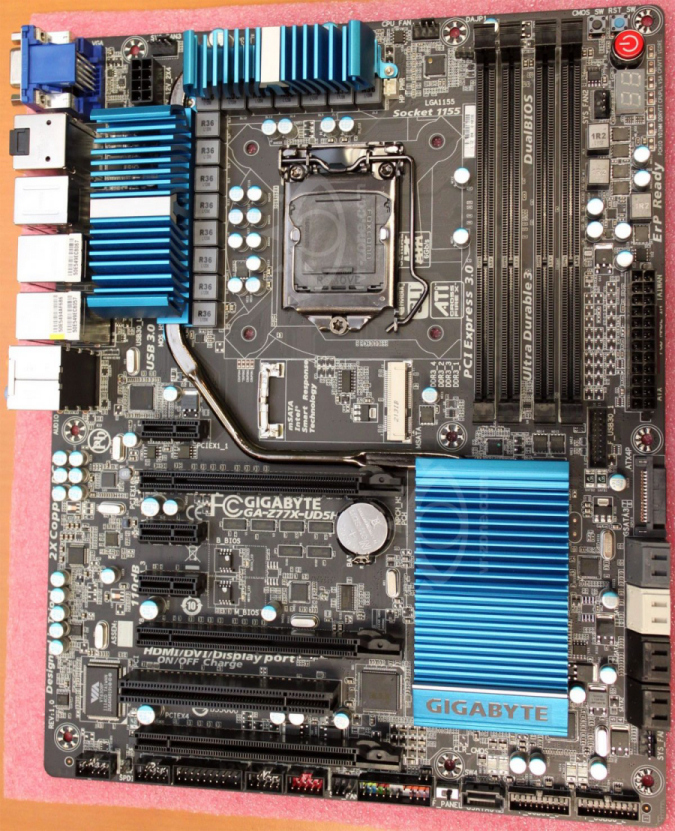
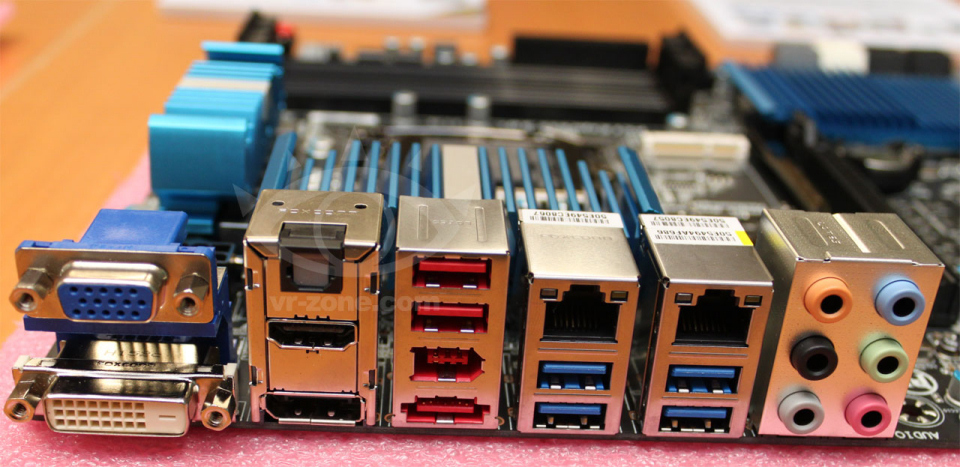
MSI
MSI Z77A-GD65
- 6-phasiges VRM
- 2x PCI-Express 3.0 x16, 1x PCI-Express 2.0 x16 (Elektrisch TBA), 4x PCI-Express 2.0 x1
- 4x SATA 6 Gb/s ports, 4x SATA 3 Gb/s
- DVI, HDMI, und D-Sub Ausgänge
- 2x USB 3.0 Extern, 4x USB 2.0 Extern, 2x USB 3.0 Intern und 6x USB 2.0 Intern
- Gigabit Ethernet, HD Audio mit SPDIF Ausgang, 2x BIOS/UEFI-Chips, OC Genie, Spannungsmesspunkte
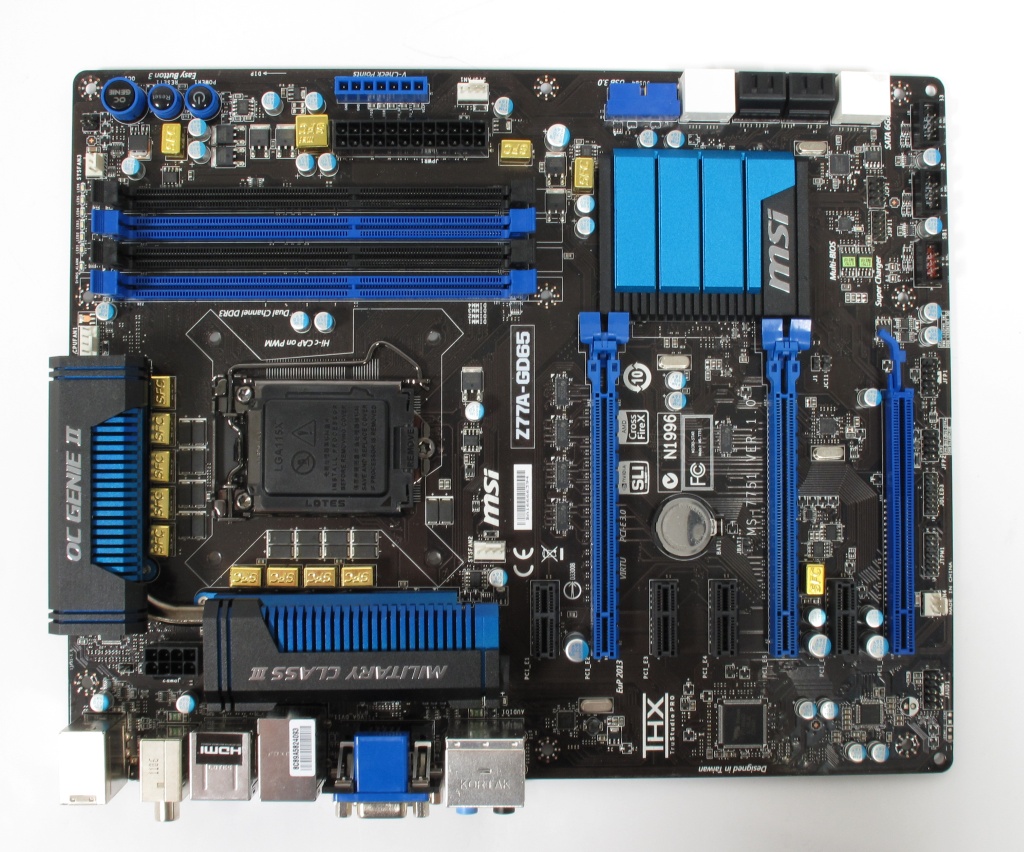
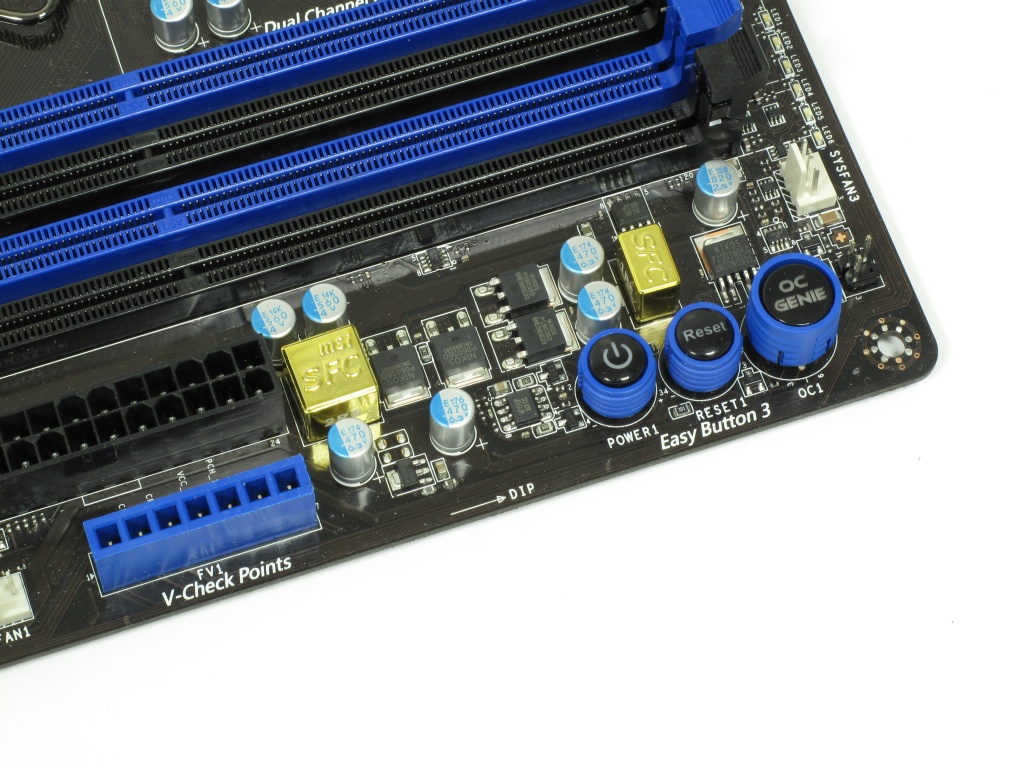
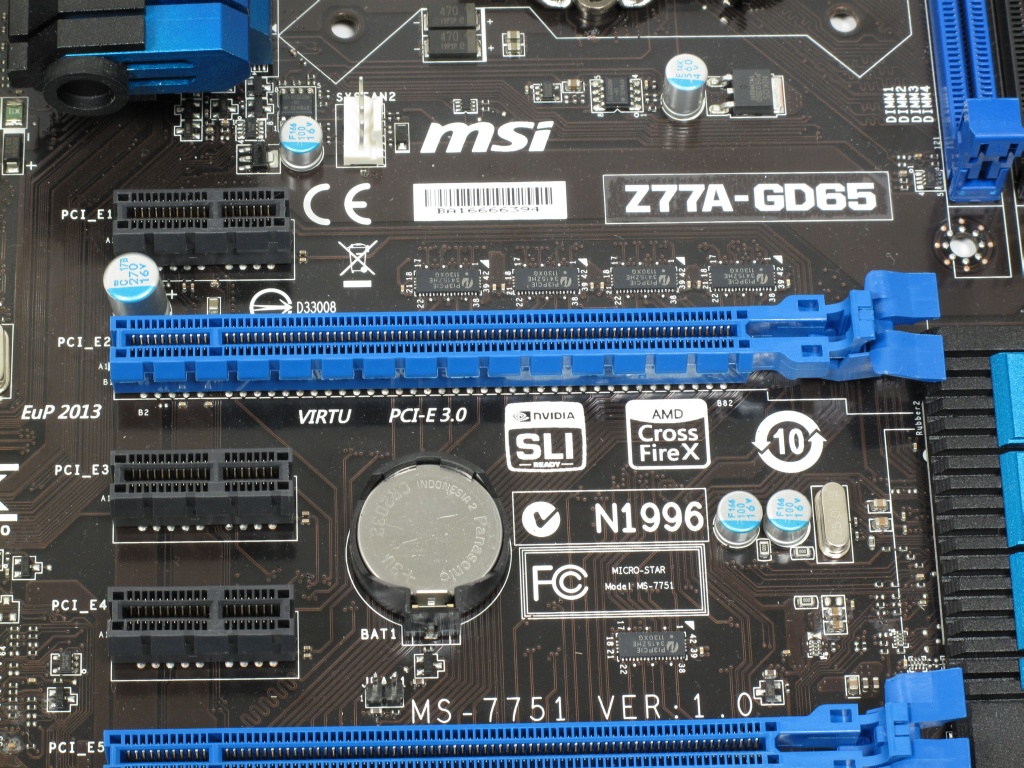
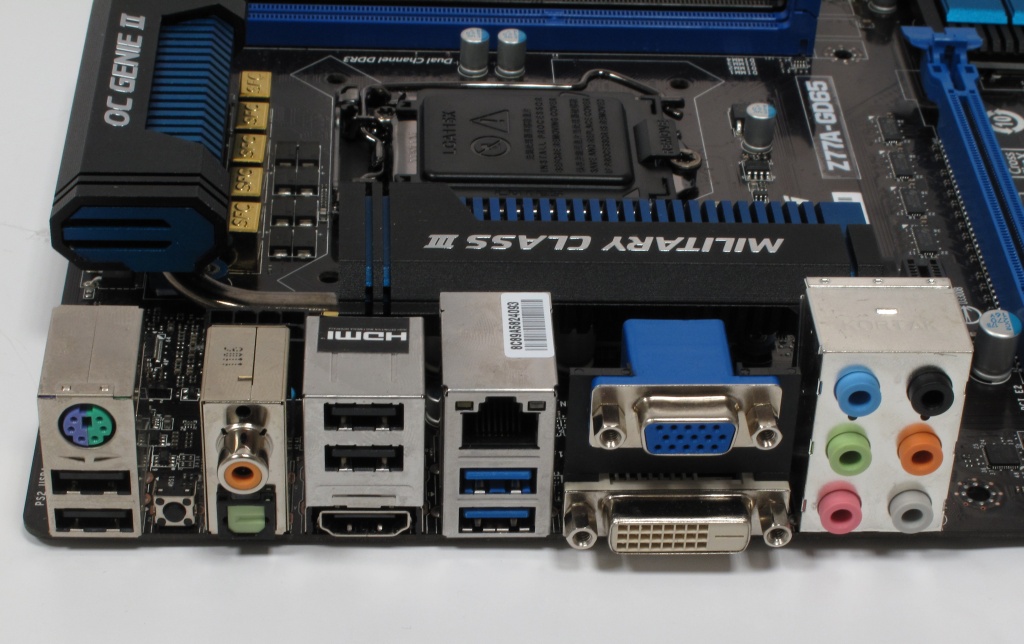
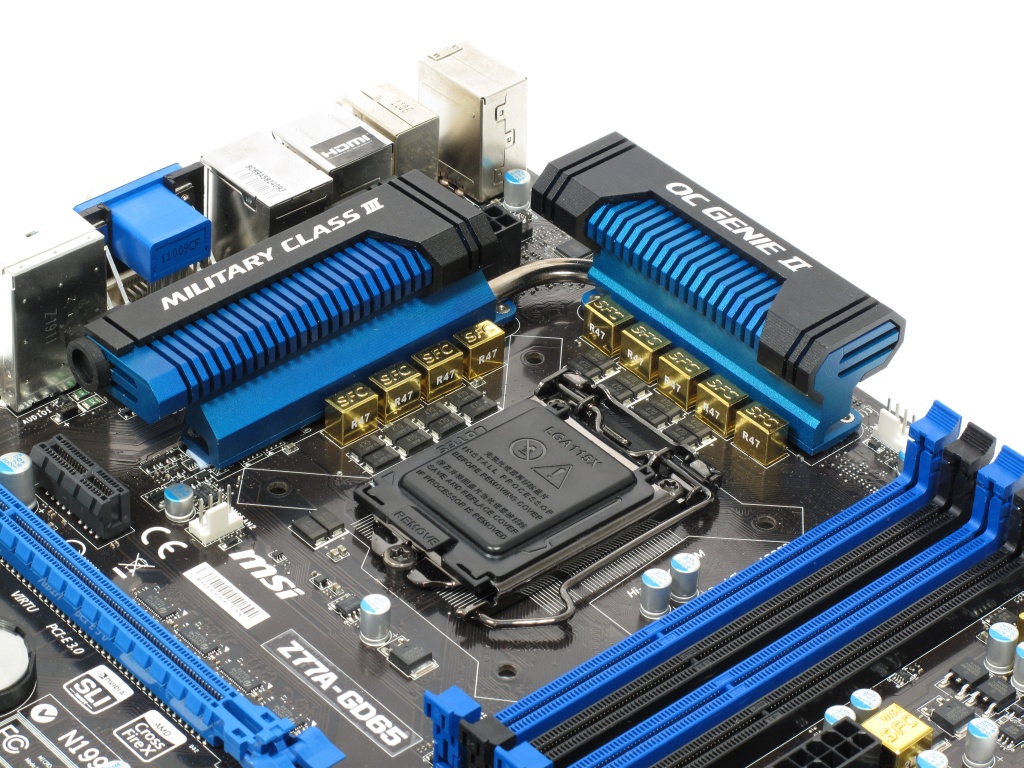
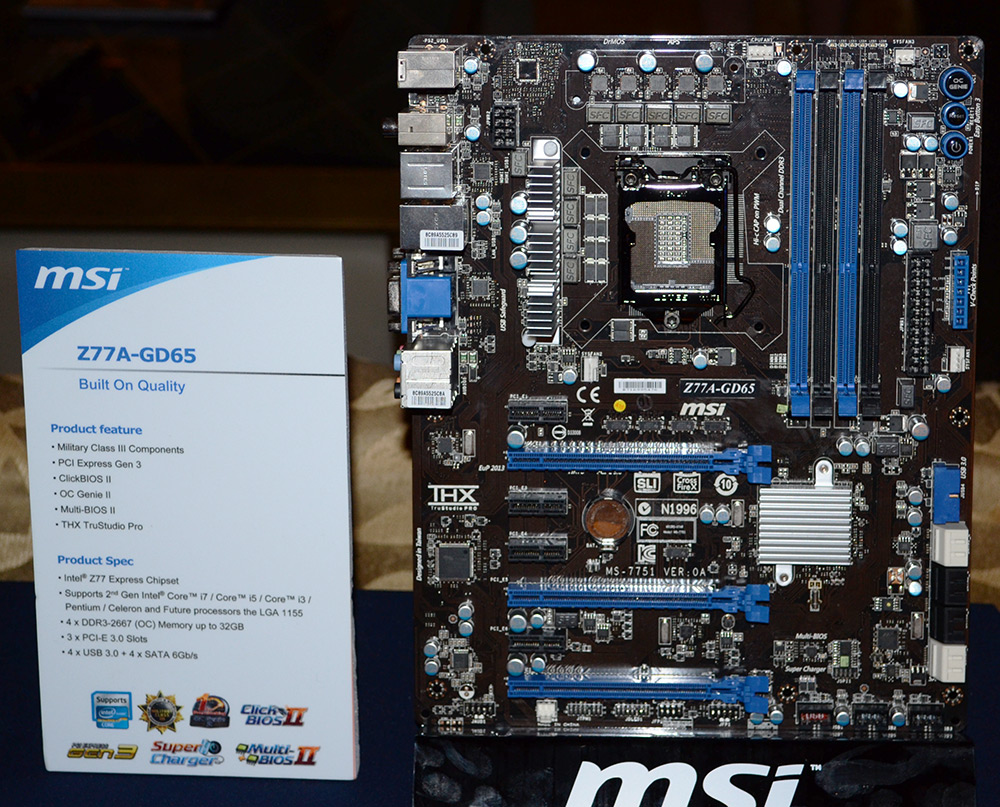
Quellen: http://www.pcgameshardware.de/aid,859008/MSI-Mainboard-Z77A-GD65-abgelichtet/Mainboard/News/
http://www.hardwareluxx.de/communit...75-h77-q77-q75-b75-807580-3.html#post18204229
MSI Z77A-GD80
- 10-phasiges VRM
- 3x PCI-Express 3.0 x16 (elektrisch x8/x8/x4 wenn alle belegt), 4x PCI-Express 2.0 x1
- 4x SATA 6 Gb/s ports, 4x SATA 3 Gb/s
- DVI, HDMI, und D-Sub Ausgänge
- Thunderbolt Anschluss
- 2x USB 3.0 Extern, 4x USB 2.0 Extern, 2x USB 3.0 Intern und 6x USB 2.0 Intern
- Gigabit Ethernet, HD Audio mit SPDIF Ausgang, 2x BIOS/UEFI-Chips, OC Genie, Spannungsmesspunkte
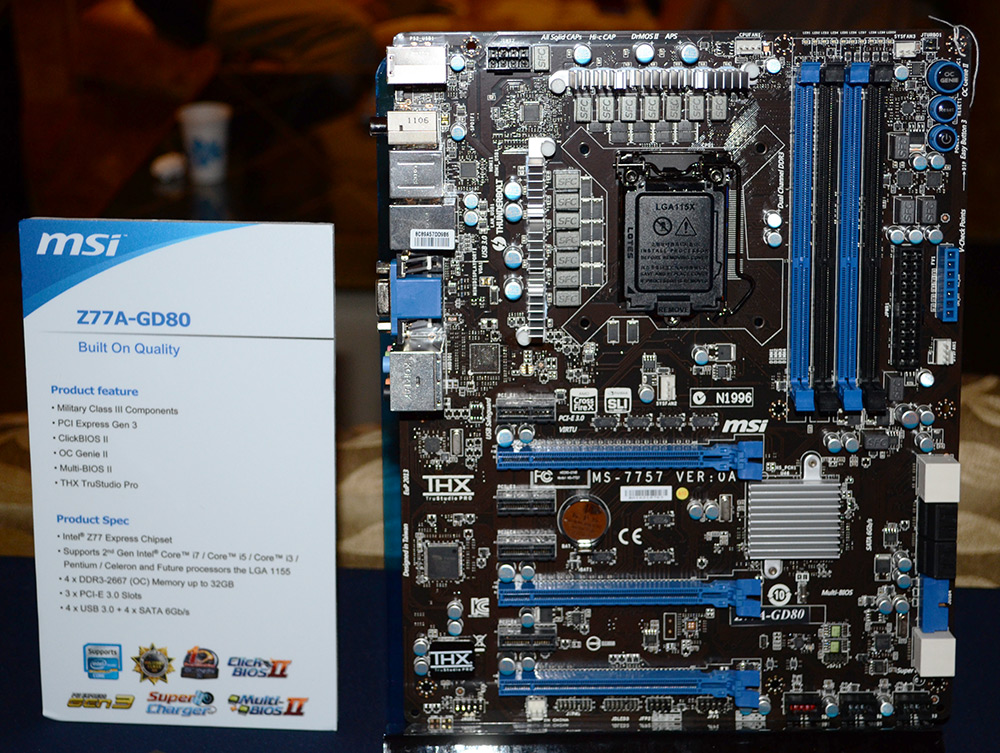
Quellen: http://www.hardwarecanucks.com/foru...herboards-mobile-graphics-upgrade-system.html
http://www.hardwareluxx.de/communit...75-h77-q77-q75-b75-807580-3.html#post18204229
Wibtek
Wibtek Hacker Z77
- 16-phasiges VRM
- 2x PCI-Express 3.0 x16 (elektrisch x8/x8 wenn beide belegt), 2x PCI-Express 2.0 x1, 2x PCI
- 6x SATA 6 Gb/s ports, 4x SATA 3 Gb/s
- DVI, HDMI, und D-Sub Ausgänge
- 6x USB 3.0 Extern, und 4x USB 3.0 Intern, 4x USB 2.0 Intern
- Gigabit Ethernet, WiFi b/g/n, Bluetooth, 8+2 channel HD Audio mit SPDIF Ausgang, Firewire
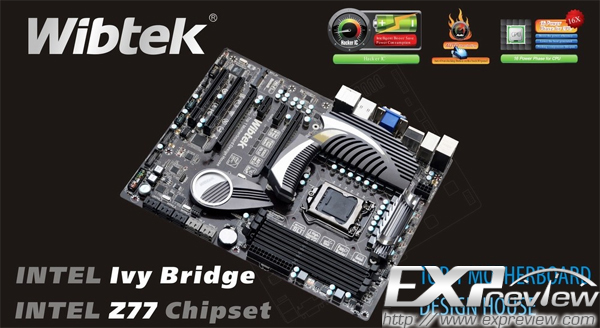
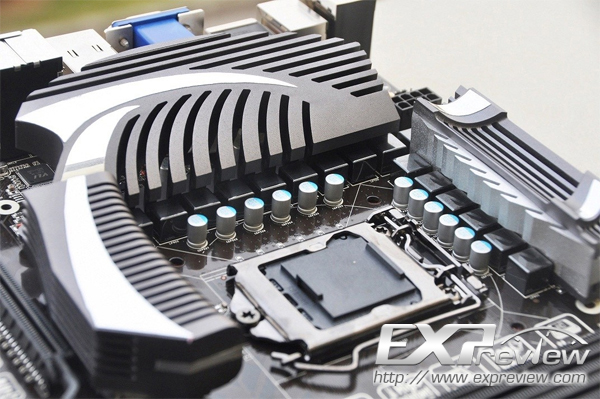
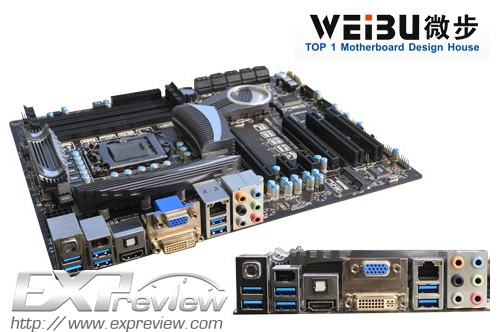
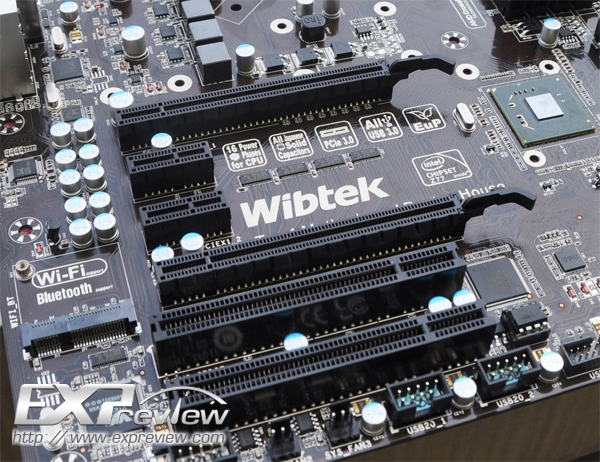
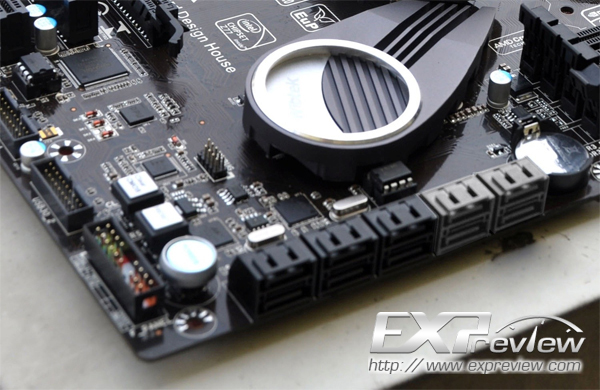
Quelle: Wibtek Hacker Z77 Motherboard Pictured | techPowerUp
Sapphire
Sapphire PT-CI7Z77
- 2x PCI-Express 3.0 x16 (elektrisch x8/x8 wenn beide belegt), 1x PCI-Express 2.0 x16, 1x PCI-E 2.0 x1, 1x PCI
- 2x SATA 6 Gb/s ports, 4x SATA 3 Gb/s
- DVI, VGA, DMI und DisplayPort Ausgänge
- ?x USB 3.0 Extern, ?x USB 2.0 Extern und 4x USB 3.0 Intern
- Gigabit Ethernet, Bluetooth, 8+2 channel HD Audio mit SPDIF Ausgang, ?

Quelle: http://www.hardwareluxx.de/communit...75-h77-q77-q75-b75-807580-3.html#post18211894
ASRock Z77 Extreme6
- 2x PCI-Express 3.0 x16 (bei SLI 8x), 1x PCI-Express 2.0 x16 (faktisch 4x über PCH), 1x PCI-E 1x, 2x PCI
- 4x SATA 6 Gb/s ports, 4x SATA 3 Gb/s
- DVI, HDMI, DisplayPort, und D-Sub Ausgänge
- 4x USB 3.0 Extern, 2x USB 2.0 Extern, 1x Gbit LAN, 1x eSATa, 1x Firewire, 2x USB 3.0 Intern, 6x USB 2.0 Intern und 1x Firewire Intern
- 12-Phasen-DigiPower-Spannungsversorgung, DDR3-2800 Support, Power/Reset Button und Debug-Anzeige


ASrock Z77 Professional (Fatal1ty):
- 3x PCI-Express 3.0 x16 (faktisch ?), 2x PCI-E 1x, 2x PCI
- 6x SATA 6 Gb/s ports, 4x SATA 3 Gb/s
- DVI, HDMI, DisplayPort, und D-Sub Ausgänge
- ?x USB 3.0 Extern, ?x USB 2.0 Extern, ?x Gbit LAN, ?x eSATa, ?x Firewire, 2x USB 3.0 Intern, 6x USB 2.0 Intern und 1x Firewire Intern
- 20-Phasen-DigiPower-Spannungsversorgung, DDR3-2800 Support, Power/Reset Button und Debug-Anzeige

ASrock Z77 Professional-M (Fatal1ty):
- 1x PCI-Express 3.0 x16, 1x 1x PCI-Express 2.0 x16 (4x angebunden über PCH), 2x PCI-E 1x, 2x PCI
- 4x SATA 6 Gb/s ports, 4x SATA 3 Gb/s
- DVI, HDMI, DisplayPort, und D-Sub Ausgänge
- ?x USB 3.0 Extern, ?x USB 2.0 Extern, ?x Gbit LAN, ?x eSATa, ?x Firewire, 2x USB 3.0 Intern, 6x USB 2.0 Intern und 1x Firewire Intern
- 11-Phasen-DigiPower-Spannungsversorgung, DDR3-2800 Support, Power/Reset Button

Asus
ASUS P8Z77-V Deluxe
- 2x PCI-Express 3.0 x16 (bei SLI x8/x8), PCI-Express 2.0 x16 (elektrisch x4, über PCH angebunden), 4x PCI-E 1x
- 4x SATA 6 Gb/s ports, 4x SATA 3 Gb/s
- HDMI und DisplayPort
- ?x USB 3.0 Extern, ?x USB 2.0 Extern, 2x Gbit LAN, 2x eSATa, ?x USB 3.0 Intern, ?x USB 2.0 Intern
- DDR3-2800 Support, Wireless b/g/n (Quad-band), Bluetooth 3.0, 8+2 Kanal-HD-Audio (Realtek ALC898)

Gigabyte
Gigabyte G1.Sniper 3
- 2x PCI-Express 3.0 x16 (bei SLI x16 dank PLX-Bridge, bei 4-way SLI x8), 2x PCI-Express 2.0 x16, 2x PCI-E 1x, 1x PCI
- 6x SATA 6 Gb/s ports, 4x SATA 3 Gb/s
- DVI, HDMI, Displayport und D-Sub Ausgänge
- 6x USB 3.0 Extern, 2x LAN Extern, 4x USB 3.0 Intern, 4x USB 2.0 Intern und 1x Firewire Intern
- Onboard Gigabit Killer Nic Network Card, Onboard Creatives Sound Core3D-Audiochip (inkl SPDIF), Intel Gigabit Network, 2x BIOS/UEFI DualBIOS, 6x SmartFan Fananschlüsse


Gigabyte G1.Sniper M3
- 2x PCI-Express 3.0 x16, 1x PCI-Express 2.0 x16 (elektrisch x8/x8/x4 wenn SLI/belegt), 1x PCI-E 1x
- 2x SATA 6 Gb/s ports, 3x SATA 3 Gb/s
- DVI, HDMI, Displayport und D-Sub Ausgänge
- 2x USB 3.0 Extern, 2x USB 2.0 Extern, 2x USB 3.0 Intern und 4x USB 2.0 Intern
- Intel Gigabit Ethernet Network Card, Onboard Creatives Sound Core3D-Audiochip (inkl SPDIF), 2x BIOS/UEFI DualBIOS, 4x SmartFan Fananschlüsse


Gigabyte GA-Z77X-UD3H
- 2x PCI-Express 3.0 x16 (elektrisch x8/x8/ bei SLI/Belegung), 1x PCI-Express 2.0 x16 (elektisch x4 über PCH angebunden), 3x PCI-E, 1x PCI
- 3x SATA 6 Gb/s ports, 4x SATA 3 Gb/s
- DVI, HDMI, Displayport und D-Sub Ausgänge
- 6x USB 3.0 Extern, 2x eSATA Extern, 2x USB 3.0 Intern, 6x USB 2.0 Intern, mSATA Intern
- Gigabit Ethernet, VIA HD Audio mit SPDIF Ausgang, 2x BIOS/UEFI DualBIOS, 4x SmartFan Fananschlüsse, Spannungsmesspunkte und Debug LEDs


Gigabyte GA-Z77X-UD5H
- 2x PCI-Express 3.0 x16 (elektrisch x8/x8/ bei SLI/Belegung), 1x PCI-Express 2.0 x16 (elektisch x4 über PCH angebunden), 3x PCI-E x1, 1x PCI
- 5x SATA 6 Gb/s ports, 4x SATA 3 Gb/s
- DVI, HDMI, Displayport und D-Sub Ausgänge
- 4x USB 3.0 Extern, 2x USB 2.0 Extern, 1x Firewire Extern, 1x eSATA Extern, 2x Lan Extern, 2x USB 3.0 Intern, 2x USB 2.0 Intern, mSATA Intern
- Gigabit Ethernet, Realtek HD Audio mit SPDIF Ausgang, 2x BIOS/UEFI DualBIOS, 4x SmartFan Fananschlüsse, Spannungsmesspunkte und Debug LEDs


MSI
MSI Z77A-GD65
- 6-phasiges VRM
- 2x PCI-Express 3.0 x16, 1x PCI-Express 2.0 x16 (Elektrisch TBA), 4x PCI-Express 2.0 x1
- 4x SATA 6 Gb/s ports, 4x SATA 3 Gb/s
- DVI, HDMI, und D-Sub Ausgänge
- 2x USB 3.0 Extern, 4x USB 2.0 Extern, 2x USB 3.0 Intern und 6x USB 2.0 Intern
- Gigabit Ethernet, HD Audio mit SPDIF Ausgang, 2x BIOS/UEFI-Chips, OC Genie, Spannungsmesspunkte






Quellen: http://www.pcgameshardware.de/aid,859008/MSI-Mainboard-Z77A-GD65-abgelichtet/Mainboard/News/
http://www.hardwareluxx.de/communit...75-h77-q77-q75-b75-807580-3.html#post18204229
MSI Z77A-GD80
- 10-phasiges VRM
- 3x PCI-Express 3.0 x16 (elektrisch x8/x8/x4 wenn alle belegt), 4x PCI-Express 2.0 x1
- 4x SATA 6 Gb/s ports, 4x SATA 3 Gb/s
- DVI, HDMI, und D-Sub Ausgänge
- Thunderbolt Anschluss
- 2x USB 3.0 Extern, 4x USB 2.0 Extern, 2x USB 3.0 Intern und 6x USB 2.0 Intern
- Gigabit Ethernet, HD Audio mit SPDIF Ausgang, 2x BIOS/UEFI-Chips, OC Genie, Spannungsmesspunkte

Quellen: http://www.hardwarecanucks.com/foru...herboards-mobile-graphics-upgrade-system.html
http://www.hardwareluxx.de/communit...75-h77-q77-q75-b75-807580-3.html#post18204229
Wibtek
Wibtek Hacker Z77
- 16-phasiges VRM
- 2x PCI-Express 3.0 x16 (elektrisch x8/x8 wenn beide belegt), 2x PCI-Express 2.0 x1, 2x PCI
- 6x SATA 6 Gb/s ports, 4x SATA 3 Gb/s
- DVI, HDMI, und D-Sub Ausgänge
- 6x USB 3.0 Extern, und 4x USB 3.0 Intern, 4x USB 2.0 Intern
- Gigabit Ethernet, WiFi b/g/n, Bluetooth, 8+2 channel HD Audio mit SPDIF Ausgang, Firewire





Quelle: Wibtek Hacker Z77 Motherboard Pictured | techPowerUp
Sapphire
Sapphire PT-CI7Z77
- 2x PCI-Express 3.0 x16 (elektrisch x8/x8 wenn beide belegt), 1x PCI-Express 2.0 x16, 1x PCI-E 2.0 x1, 1x PCI
- 2x SATA 6 Gb/s ports, 4x SATA 3 Gb/s
- DVI, VGA, DMI und DisplayPort Ausgänge
- ?x USB 3.0 Extern, ?x USB 2.0 Extern und 4x USB 3.0 Intern
- Gigabit Ethernet, Bluetooth, 8+2 channel HD Audio mit SPDIF Ausgang, ?

Quelle: http://www.hardwareluxx.de/communit...75-h77-q77-q75-b75-807580-3.html#post18211894
Zuletzt bearbeitet:




 ^^
^^